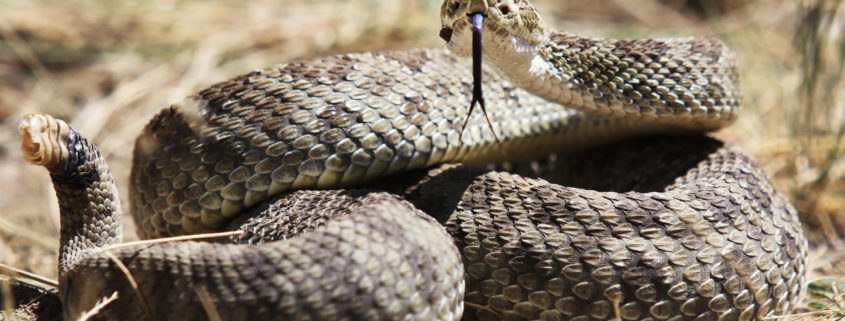Rattlesnake Tips that could Save Your Dog’s Life
Rattlesnakes live in so many areas and can be a life-threatening danger to dogs of all sizes. But with just a few preventive steps, you can reduce the chances your dog will get bitten and die from a rattlesnake bite! Rattlesnakes are very common the parks and trails that many dog-lovers use for hikes and walks with their dogs. More and more homes are being built in areas that were previously rural, making encounters with wildlife even more common. If you and your dog live in an apartment in a totally urban (cement city) area and never goes on walks in a park, then you don’t need these tips. But the majority of pet owners would be prudent in following them! Being prepared takes education about avoidance and – most importantly – a trip to the vet. Read on for our tips to prevent a fatal rattlesnake bite, and what to do if your dog is bitten!
- Get your dog the rattlesnake vaccine.
There is a dog vaccine by Red Rock Biologics for rattlesnake bites. The vaccine is made from snake venom and works in a way so that if your dog is bitten, the reaction to the bite is REDUCED and may be delayed – it is not completely eliminated, so a vaccinated dog bitten by a rattlesnake will still need vet care as soon as possible.
- Walk your dog on a 6-foot leash.
If you hear a rattle or see a snake on the ground ahead of you, if your dog is on a 6-foot leash, you can avoid it. Vets say the vast majority of rattlesnake bites occur when a dog is off-leash or on a flexible-lead.
- Avoid rocky or dense brush or grassy areas.
On your walks with your dog, stay on the trail, and choose wide trails or roads over narrow brush-bordered trails if possible. That way you are more likely to see a snake sunning itself across your path, and be able to stop and avoid it in time. Also, keep your yard grass cut short and eliminate brush, piles of rocks where snakes like to sun themselves as well as hide.
- Snake-proof your yard.
Your yard may be fenced to keep Fido safely in, but it won’t keep most snakes out unless you fortify it. Snakes can get under fencing that does not have a solid cement base (like a block wall). On wood fences or solid iron fences, use hardware cloth all along the base of your fence, including across any gated areas. You’ll need to dig a trench to bury 22″ of it into the ground, with 18″ above ground attached to the base of your fence. Hardware cloth runs about $100 per 100 feet — expensive, but if you live in a rattlesnake-dense area and want your dog to be safe in your yard, the cost may be worth it.
- Know a dog’s rattlesnake-bite symptoms.
If you don’t recognize the symptoms of a rattlesnake bite in your dog, you might delay rushing them to the vet immediately – and that delay could be fatal.
Immediate symptoms almost always include:
- puncture wounds (can be bleeding)
- severe pain
- swelling
- restlessness, panting or drooling
Depending on how much venom the bite injected into your dog, and the size of your dog, any of these more severe symptoms may appear quickly or within a few hours:
- lethargy, weakness, sometimes collapse
- muscle tremors
- diarrhea
- seizures
- neurological signs including depressed respiration
- If you & your dog encounter a rattlesnake…
Calmly & slowly back away from the snake until you are no longer within striking distance (about the snake’s length) and until the snake stops rattling at you. Then carefully leave the area – if there is one snake, there are likely to be more in that same area.
- If your dog is bitten by a rattlesnake…
If you can, carry your dog to your car. If you can’t carry your dog without them (or you!) struggling, walk them to your car. Limiting the dog’s activity will limit the venom moving around in their body, which is better. THEN GET THEM TO A VET IMMEDIATELY! The faster your dog can get the anti-venom and other emergency treatment from the vet, the greater their chance of survival.



